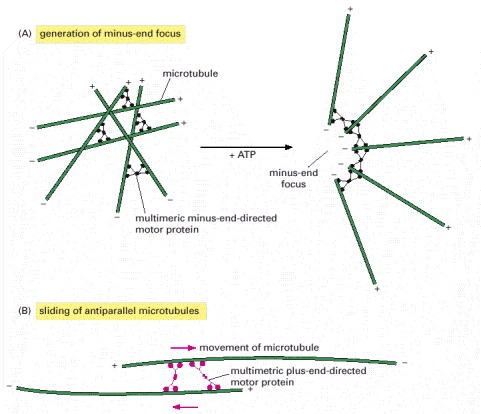NCBI Bookshelf. A service of the National Library of Medicine, National Institutes of Health.
Alberts B, Johnson A, Lewis J, et al. Molecular Biology of the Cell. 4th edition. New York: Garland Science; 2002.

Molecular Biology of the Cell. 4th edition.
Show details
Figure 18-13Two functions of multimeric motor proteins that are important for mitotic spindle assembly and function
Microtubule-dependent motor proteins hydrolyze ATP and move along a microtubule toward either its plus or its minus end. If the motor protein is multimeric, as in these examples, it can cross-link two adjacent microtubules and move them relative to one another. (A) Some minus-end-directed multimeric motor proteins rearrange microtubules to form a focus of minus ends, where the motor proteins accumulate. (B) If microtubules are aligned so that they are antiparallel (that is, their plus ends are facing in opposite directions), a cross-linking motor protein can slide the microtubules past each other, as shown here for a plus-end-directed motor protein that could elongate the spindle. (Adapted from A.A. Hyman and E. Karsenti, Cell 84:406–410, 1996.)
- Figure 18-13, Two functions of multimeric motor proteins that are important for ...Figure 18-13, Two functions of multimeric motor proteins that are important for mitotic spindle assembly and function - Molecular Biology of the Cell
Your browsing activity is empty.
Activity recording is turned off.
See more...